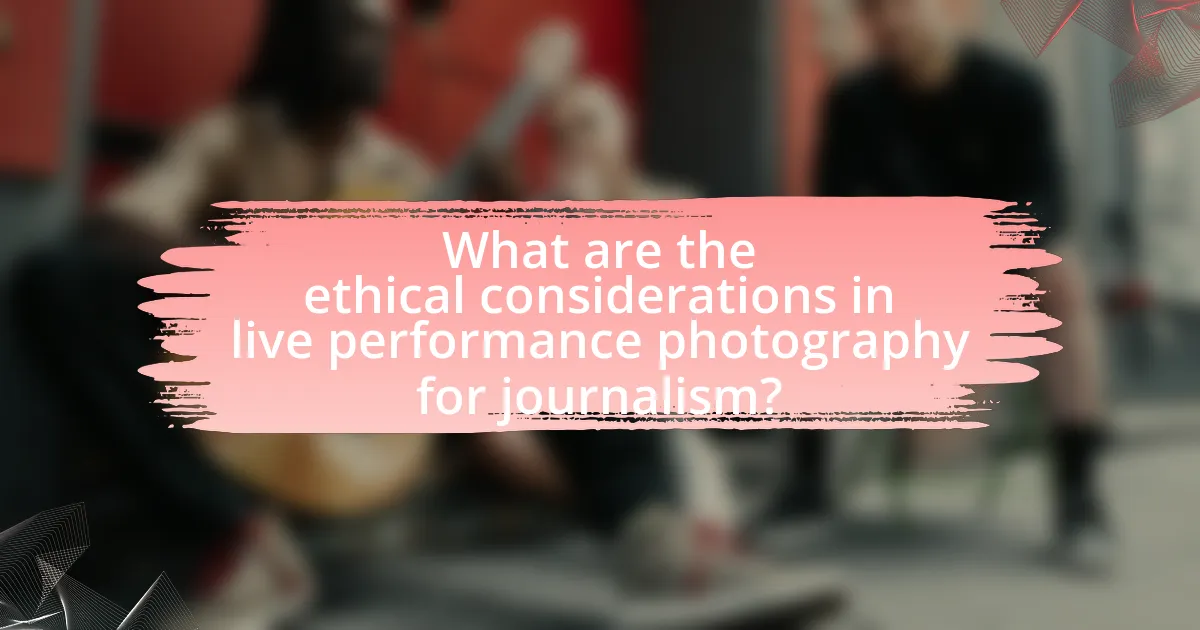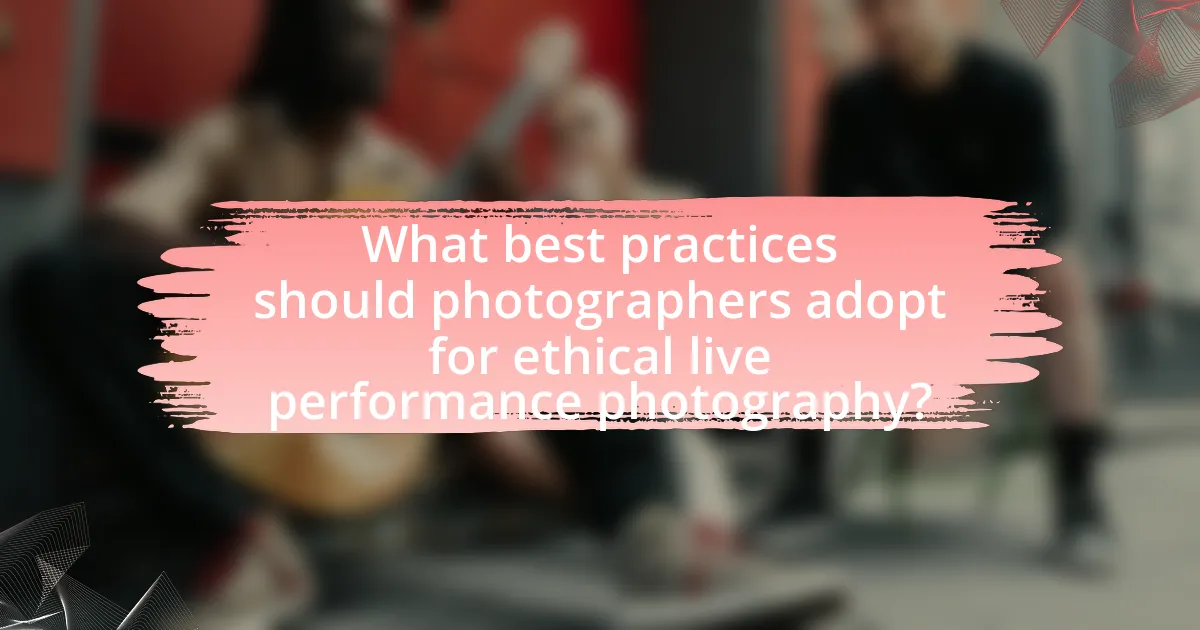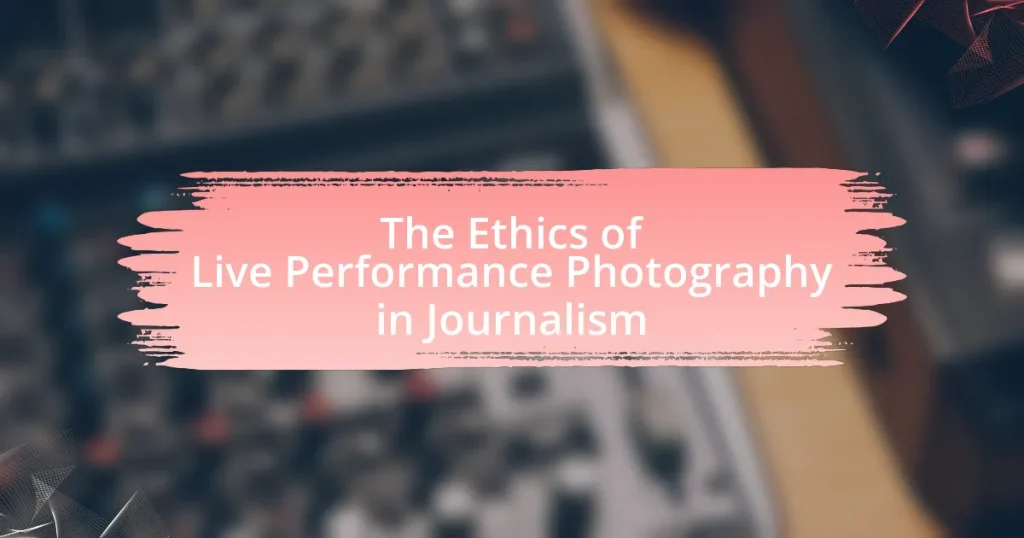The article focuses on the ethical considerations surrounding live performance photography in journalism. It outlines the importance of obtaining consent from subjects, respecting privacy, and accurately representing events without manipulation. Key ethical principles include honesty, accountability, and respect for performers and audiences, which vary across different types of performances. The article also discusses the legal framework governing photography, including copyright and privacy laws, and emphasizes best practices for photographers to maintain ethical standards while documenting live performances. Additionally, it highlights the significance of audience perception and the potential consequences of negative reactions, underscoring the need for photographers to navigate ethical dilemmas responsibly.

What are the ethical considerations in live performance photography for journalism?
Ethical considerations in live performance photography for journalism include obtaining consent from subjects, respecting the privacy of individuals, and accurately representing the event without manipulation. Photographers must ensure that they have permission to capture images, especially in settings where individuals may expect privacy, such as backstage areas. Additionally, ethical journalism mandates that images should not be altered to misrepresent the event or the subjects involved, maintaining integrity and truthfulness in reporting. The Society of Professional Journalists emphasizes the importance of minimizing harm and being accountable, which reinforces the need for ethical practices in photography.
How do ethics influence the practice of live performance photography?
Ethics significantly influence the practice of live performance photography by guiding photographers in their decision-making regarding consent, representation, and the impact of their work on subjects and audiences. Photographers must obtain permission from performers and respect their boundaries, as unauthorized images can violate personal rights and lead to legal repercussions. Furthermore, ethical considerations dictate that photographers should accurately represent the performance without manipulation or misrepresentation, ensuring that the audience receives a truthful depiction of the event. For instance, the National Press Photographers Association emphasizes the importance of integrity and respect in visual journalism, highlighting that ethical practices foster trust between photographers, subjects, and the public.
What are the key ethical principles that photographers should follow?
Photographers should follow key ethical principles such as respect for subjects, honesty in representation, and accountability for their work. Respect for subjects involves obtaining consent and being sensitive to the context in which images are taken, particularly in live performance settings where individuals may not expect to be photographed. Honesty in representation requires photographers to avoid manipulation of images that could mislead viewers, ensuring that the portrayal of events is truthful and accurate. Accountability entails taking responsibility for the impact of their images, including the potential consequences for subjects and the audience. These principles are essential in maintaining integrity and trust in journalism, particularly in live performance photography, where the immediacy and emotional weight of the moment can significantly influence public perception.
How do ethical considerations differ between various types of performances?
Ethical considerations differ significantly between various types of performances, particularly in the context of live performance photography in journalism. In theatrical performances, ethical guidelines often emphasize respect for the artistic integrity and intent of the creators, requiring photographers to avoid disrupting the performance or misrepresenting the work. Conversely, in concert photography, ethical considerations may focus on the rights of the performers and the audience, where capturing candid moments is encouraged but must respect the performers’ consent and the venue’s policies.
Moreover, in journalistic contexts, ethical standards dictate that photographers must accurately represent the event without manipulation or staging, ensuring that the images convey the truth of the performance. For instance, the National Press Photographers Association (NPPA) outlines ethical standards that emphasize honesty and integrity in visual journalism, reinforcing the need for ethical practices across different performance types. Thus, the ethical landscape varies based on the nature of the performance, the intent of the photography, and the expectations of the audience and performers involved.
Why is consent important in live performance photography?
Consent is important in live performance photography because it respects the rights and autonomy of individuals being photographed. Obtaining consent ensures that performers and audience members have control over their image and how it is used, which is a fundamental ethical principle in journalism. For instance, the American Society of Media Photographers emphasizes the necessity of consent to avoid legal repercussions and to maintain trust between photographers and subjects. This ethical practice not only protects individuals from potential exploitation but also fosters a respectful relationship that can enhance the quality and integrity of the photographic work.
What constitutes informed consent in the context of live performances?
Informed consent in the context of live performances involves obtaining explicit permission from participants before capturing or disseminating their images or performances. This consent must be based on a clear understanding of how the images will be used, the potential risks involved, and the context in which the performance occurs. For instance, performers should be informed if their images will be used for commercial purposes or in media that may reach a wide audience. Legal frameworks, such as copyright laws and privacy rights, support the necessity of informed consent, ensuring that individuals retain control over their likeness and the representation of their performances.
How can photographers ensure they obtain proper consent from performers?
Photographers can ensure they obtain proper consent from performers by using clear, written agreements that outline the scope of the photography, the intended use of the images, and the rights of the performers. This practice is essential because it establishes mutual understanding and protects both parties legally. According to the American Society of Media Photographers, obtaining written consent is a best practice that helps avoid disputes over image usage and respects the performers’ rights. Additionally, discussing the project openly with performers before the shoot fosters trust and transparency, further ensuring that consent is informed and voluntary.
What role does audience perception play in the ethics of live performance photography?
Audience perception significantly influences the ethics of live performance photography by shaping the expectations and boundaries of what is considered acceptable in capturing and sharing images. When audiences perceive live performance photography as intrusive or disrespectful, it raises ethical concerns regarding the privacy and consent of performers and attendees. For instance, studies have shown that audiences often expect a certain level of respect for the performers’ space, which can dictate the ethical considerations photographers must navigate. Additionally, audience reactions can impact the reputation of both the photographer and the publication, as negative perceptions may lead to backlash against those who disregard ethical standards. Thus, understanding audience perception is crucial for photographers to align their practices with ethical norms in journalism.
How can photographers balance artistic expression with audience expectations?
Photographers can balance artistic expression with audience expectations by understanding their audience while maintaining their unique style. This involves researching the preferences and interests of their target demographic, which can guide the creative process without compromising artistic integrity. For instance, a study published in the Journal of Visual Culture highlights that photographers who engage with their audience through social media can better align their work with audience expectations while still expressing their artistic vision. By integrating feedback and trends into their work, photographers can create images that resonate with viewers while showcasing their personal artistry.
What are the potential consequences of negative audience reactions?
Negative audience reactions can lead to significant consequences for performers and journalists involved in live performance photography. These reactions may result in diminished audience engagement, which can negatively impact ticket sales and future attendance. Additionally, negative feedback can harm the reputation of both the performers and the journalists, leading to a loss of credibility and trust within the industry. For instance, a study published in the Journal of Communication found that negative audience perceptions can lead to a 30% decrease in future event attendance. Furthermore, such reactions can create a hostile environment, affecting the overall atmosphere of the performance and potentially leading to increased security concerns.

How does the legal framework impact live performance photography ethics?
The legal framework significantly impacts live performance photography ethics by establishing guidelines for copyright, privacy, and consent. Photographers must navigate laws that protect the intellectual property of performers and venues, which can dictate how images are used and distributed. For instance, the Copyright Act grants performers rights over their likeness and performances, requiring photographers to obtain permission for commercial use of images. Additionally, privacy laws may restrict photographing individuals in certain contexts without consent, emphasizing the ethical obligation to respect personal boundaries. These legal stipulations shape the ethical landscape by ensuring that photographers balance their creative expression with the rights of those they capture, thereby fostering responsible practices in live performance photography.
What laws govern live performance photography in journalism?
Laws governing live performance photography in journalism primarily include copyright law, privacy law, and contract law. Copyright law protects the rights of photographers over their images, allowing them to control reproduction and distribution. Privacy law restricts the use of images of individuals without consent, particularly in private settings, while contract law comes into play when photographers enter agreements with event organizers or venues, which may impose specific restrictions on photography. These legal frameworks ensure that the rights of both the photographers and the subjects are respected, balancing the need for journalistic expression with individual privacy rights.
How do copyright laws affect the use of performance images?
Copyright laws significantly restrict the use of performance images by granting exclusive rights to the creators and performers depicted in those images. These laws ensure that photographers, artists, and performers maintain control over how their work is reproduced, distributed, and displayed. For instance, under the U.S. Copyright Act, performance images are protected as artistic works, meaning that unauthorized use, such as publication in journalism without permission, can lead to legal repercussions. This legal framework is designed to protect the intellectual property rights of individuals involved in the performance, thereby influencing how journalists can ethically and legally utilize such images in their reporting.
What are the implications of privacy laws for photographers?
Privacy laws significantly impact photographers by restricting their ability to capture and distribute images of individuals without consent. These laws, such as the General Data Protection Regulation (GDPR) in Europe and various state privacy statutes in the United States, mandate that photographers obtain explicit permission from subjects before photographing them in private settings. Failure to comply can result in legal repercussions, including fines and lawsuits. For instance, under GDPR, individuals have the right to control their personal data, which includes images, leading to increased scrutiny on how photographers manage and share their work. This legal framework necessitates that photographers be vigilant about obtaining consent and understanding the specific privacy regulations applicable in their jurisdiction to avoid potential violations.
How can photographers navigate legal challenges in live performance settings?
Photographers can navigate legal challenges in live performance settings by obtaining proper permissions and understanding copyright laws. Securing a release form from event organizers or performers ensures that photographers have the right to capture and use images. Additionally, photographers should familiarize themselves with the venue’s policies regarding photography, as many venues have specific rules that must be followed. Understanding the Fair Use doctrine is also crucial, as it allows for limited use of copyrighted material under certain conditions, such as commentary or criticism. By adhering to these practices, photographers can minimize legal risks and protect their work.
What steps should photographers take to protect themselves legally?
Photographers should take several key steps to protect themselves legally, including obtaining model releases, securing copyright for their images, and understanding licensing agreements. Model releases are essential for gaining permission from subjects to use their likeness, which is particularly important in commercial contexts. Copyright registration provides legal protection against unauthorized use of images, allowing photographers to enforce their rights. Additionally, photographers must carefully review and negotiate licensing agreements to ensure they retain control over how their work is used and to avoid potential legal disputes. These steps are critical in the context of live performance photography, where the ethical implications of image use can intersect with legal considerations.
How can understanding legal rights enhance ethical practices?
Understanding legal rights enhances ethical practices by providing a framework that guides individuals in making informed decisions that respect both the law and moral standards. When journalists comprehend copyright laws, privacy rights, and consent requirements, they can navigate the complexities of live performance photography responsibly. For instance, the U.S. Copyright Act protects the rights of photographers, ensuring that their work is not used without permission, which reinforces the ethical obligation to respect creators’ rights. Additionally, understanding the legal implications of photographing individuals in public spaces helps journalists avoid potential legal disputes while maintaining ethical integrity. This knowledge fosters a culture of accountability and respect, ultimately leading to more responsible journalism practices.

What best practices should photographers adopt for ethical live performance photography?
Photographers should obtain explicit permission from performers and event organizers before capturing images during live performances. This practice respects the rights of the artists and ensures that the photographers are not infringing on any agreements or contracts that may exist regarding the use of images. Additionally, photographers should be mindful of the venue’s policies on photography, as many venues have specific rules that must be followed to maintain a respectful environment.
Furthermore, photographers should avoid using flash photography, as it can be disruptive to both the performers and the audience. Instead, they should rely on natural or ambient lighting to capture the essence of the performance without causing interruptions.
Lastly, photographers should credit the performers and the event when sharing images publicly, acknowledging their work and contributions. This not only fosters goodwill but also aligns with ethical standards in journalism, where proper attribution is essential.
How can photographers maintain transparency with their subjects?
Photographers can maintain transparency with their subjects by clearly communicating their intentions and the context of the photography session. This involves discussing how the images will be used, obtaining consent, and ensuring that subjects understand their rights regarding the photographs. For instance, a study by the National Press Photographers Association emphasizes the importance of informed consent in ethical photography practices, highlighting that transparency fosters trust and respect between photographers and subjects.
What are effective ways to communicate with performers before and after events?
Effective ways to communicate with performers before and after events include establishing clear channels of communication, such as email or messaging apps, and scheduling pre-event meetings to discuss expectations and logistics. This approach ensures that performers are informed about event details and can voice any concerns or preferences. Additionally, following up with a debrief after the event allows for feedback exchange, which can enhance future collaborations. Research indicates that effective communication fosters trust and improves performance outcomes, as highlighted in studies on team dynamics in performance settings.
How can photographers document performances while respecting performers’ boundaries?
Photographers can document performances while respecting performers’ boundaries by obtaining explicit consent from the performers before capturing images. This practice ensures that performers are aware of how their likeness will be used and allows them to set limits on what is acceptable. Research indicates that consent is a fundamental ethical principle in photography, particularly in sensitive environments like live performances, where personal expression and vulnerability are often present. By prioritizing communication and establishing trust, photographers can create a respectful environment that honors the performers’ autonomy and comfort levels.
What are the common pitfalls to avoid in live performance photography?
Common pitfalls to avoid in live performance photography include poor lighting management, lack of preparation, and failure to respect the performers and audience. Poor lighting can lead to underexposed or overexposed images, diminishing the quality of the photographs. Lack of preparation, such as not scouting the venue or understanding the performance schedule, can result in missed opportunities for impactful shots. Additionally, failing to respect the performers’ space and the audience’s experience can lead to intrusive behavior, which is unethical in journalism. These pitfalls can compromise the integrity and quality of the photographic work, making it essential for photographers to be aware of and avoid them.
What ethical dilemmas frequently arise during live performances?
Ethical dilemmas that frequently arise during live performances include issues of consent, representation, and the potential for exploitation. Consent is critical, as performers and audience members may not always be aware that they are being photographed or recorded, raising questions about privacy rights. Representation concerns emerge when images are used in ways that misinterpret or misrepresent the performance or the performers themselves, potentially leading to harmful stereotypes. Exploitation can occur when photographers prioritize sensationalism over ethical considerations, capturing moments that may harm the subjects involved. These dilemmas highlight the need for ethical guidelines in live performance photography to ensure respect for all parties involved.
How can photographers learn from past mistakes in ethical practices?
Photographers can learn from past mistakes in ethical practices by critically analyzing previous work and identifying instances where ethical guidelines were compromised. This reflective process allows photographers to recognize the impact of their decisions on subjects and audiences, fostering a deeper understanding of ethical standards in journalism. For example, a study by the National Press Photographers Association highlights that photographers who engage in peer reviews and discussions about ethical dilemmas are more likely to adhere to ethical practices in future assignments. By implementing feedback mechanisms and staying informed about evolving ethical standards, photographers can improve their decision-making and enhance the integrity of their work in live performance photography.
What practical tips can enhance ethical live performance photography?
To enhance ethical live performance photography, photographers should prioritize obtaining consent from performers and event organizers before capturing images. This practice respects the rights of individuals and aligns with ethical standards in journalism. Additionally, photographers should be mindful of the context in which they are shooting, ensuring that their images accurately represent the event and do not mislead viewers. For instance, adhering to venue policies regarding photography can prevent potential conflicts and maintain professional integrity. Furthermore, photographers should avoid intrusive behavior that disrupts the performance or audience experience, thereby fostering a respectful environment. These practices are supported by ethical guidelines from organizations such as the National Press Photographers Association, which emphasizes the importance of integrity and respect in visual journalism.
How can photographers develop a personal code of ethics for their work?
Photographers can develop a personal code of ethics by reflecting on their values, understanding the impact of their work, and establishing guidelines that prioritize integrity and respect for subjects. This process involves identifying key ethical principles such as honesty, consent, and accountability, which are essential in live performance photography, especially in journalism where the portrayal of events can influence public perception. Research indicates that ethical frameworks in photography can enhance credibility and trust, as seen in the guidelines set by professional organizations like the National Press Photographers Association, which emphasizes the importance of ethical standards in visual journalism. By adhering to these principles, photographers can ensure their work aligns with both personal and professional ethical expectations.
What resources are available for photographers seeking to improve their ethical practices?
Photographers seeking to improve their ethical practices can access several resources, including professional organizations, online courses, and ethical guidelines. Organizations such as the National Press Photographers Association (NPPA) provide a code of ethics and educational materials focused on responsible photography. Online platforms like Coursera and LinkedIn Learning offer courses on ethics in photography, covering topics such as consent and representation. Additionally, books like “Photojournalism Ethics: A Handbook for the Digital Age” by David Campbell provide in-depth discussions on ethical dilemmas faced by photographers in journalism. These resources collectively support photographers in navigating ethical challenges effectively.


